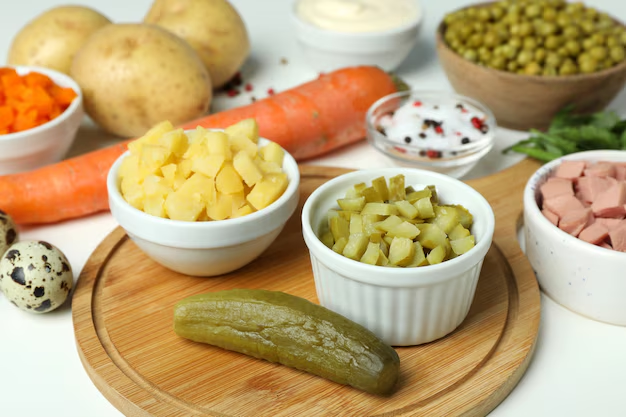Dill Pickles and Diabetes: Are They a Good Match?
For anyone living with diabetes, dietary choices are more than just decisions about taste; they can significantly impact health and daily management of the condition. Among the myriad food options available, dill pickles might stand out with their tangy flavor and crunchy texture. But are dill pickles a suitable choice for individuals with diabetes? This question, though simple on the surface, invites an exploration into the nutritional content of dill pickles and their potential effects on blood sugar levels. Let’s delve into this topic to uncover the facts and provide guidance for informed choices.
The Nutritional Profile of Dill Pickles
Why Pickles Matter
Dill pickles are cucumbers preserved in a solution of vinegar, water, salt, and dill, sometimes with added garlic or other spices for flavor. Understanding these ingredients—particularly the vinegar and salt—is key to evaluating whether dill pickles are beneficial for those managing diabetes.
Key Components
Low in Calories and Carbohydrates: Dill pickles are generally low in calories and carbohydrates, making them an attractive option for those watching their carbohydrate intake.
Vinegar Content: Some perspectives suggest that vinegar, a primary component in pickling solutions, might contribute positively to blood sugar regulation.
High Sodium Levels: The salt content in dill pickles is significant, posing considerations related to blood pressure and overall heart health, which are critical for individuals with diabetes.
Glycemic Impact: Minimal, But Noteworthy
The glycemic index (GI) is a tool used to measure how foods impact blood sugar levels. Foods with a low GI cause a slower, more gradual rise in blood glucose levels. Dill pickles, due to their low carbohydrate content, generally have a low glycemic impact, making them a minimal concern for immediate blood sugar spikes.
Vinegar: A Potential Ally?
Exploring Vinegar’s Role
Vinegar is known for its potential to improve insulin sensitivity and control blood sugar levels after meals. Its presence in pickles could, therefore, add a layer of benefit beyond just flavor.
Insulin Sensitivity: Enhanced insulin action can aid in better glucose management.
Satiety and Appetite Control: Vinegar may increase feelings of fullness, which could assist in weight management—a common consideration for those with diabetes.
Practical Considerations
While vinegar in pickles can be a useful component, relying heavily on pickles for vinegar intake isn’t advisable. Instead, incorporating vinegar through various dietary methods might be more beneficial.
Sodium Concerns: Packing a Punch?
Health Implications of High Sodium
One of the biggest considerations when consuming dill pickles is the high sodium content. While sodium is an essential nutrient, too much can contribute to high blood pressure—a common complication for people with diabetes.
Daily Intake Recommendations: The recommendation for sodium intake is typically around 2,300 mg per day for healthy adults, but this can be lower for those with certain health conditions.
Balance and Moderation: Consume dill pickles in moderation, and consider the rest of the day's sodium intake to maintain balanced levels.
Managing Sodium While Enjoying Pickles
Choose Low-Sodium Varieties: Opt for pickles that specify lower sodium on their packaging.
Homemade Pickles: Creating pickles at home allows control over sodium content.
Dill Pickles as Part of a Diabetes-Friendly Diet
Complementary Components
Fiber Content: While not as fibrous as raw cucumbers, pickles do retain some fiber content, which can aid in digestive health.
Pairing with Proteins: Combining dill pickles with proteins can create satisfying, balanced snacks or meals.
Incorporate with Other Healthy Foods
Including pickles as part of a balanced diet that prioritizes lean proteins, whole grains, and plenty of vegetables can enhance their benefits without overemphasizing potential pitfalls.
A Balanced Perspective on Dill Pickles for Diabetics
Key Takeaways
Here’s a summary to distill the insights on dill pickles for those concerned with diabetes management:
🧂 Keep an Eye on Sodium: Limit the number of pickles consumed to keep daily sodium intake within recommended levels.
🥒 Enjoy in Moderation: While low in carbohydrates, moderation ensures they’re part of a balanced diet without over-relying on one food type.
✅ Vinegar Benefits: Utilize the potential insulin sensitivity benefits of vinegar but seek out other vinegar-rich foods and dressings for variety.
🔍 Balance is Key: Pair pickles with protein and fiber-rich foods for more robust nutrition.
Summarizing Strategies
In the quest to incorporate dill pickles responsibly, these strategies can guide positive habits:
- Moderate Portions: Limit consumption to avoid excess sodium.
- Choose Wisely: Select low-sodium or homemade options when possible.
- Integrate, Don't Isolate: Use pickles as a complement to a diverse nutrient-rich diet.
- Monitor Responses: Pay attention to how your body responds to dill pickles, particularly in conjunction with other foods.
Utilizing dill pickles requires a mindful approach—appreciating their flavor and potential benefits while respecting their limitations. By incorporating them thoughtfully, they can fit comfortably within a diabetes management plan.
